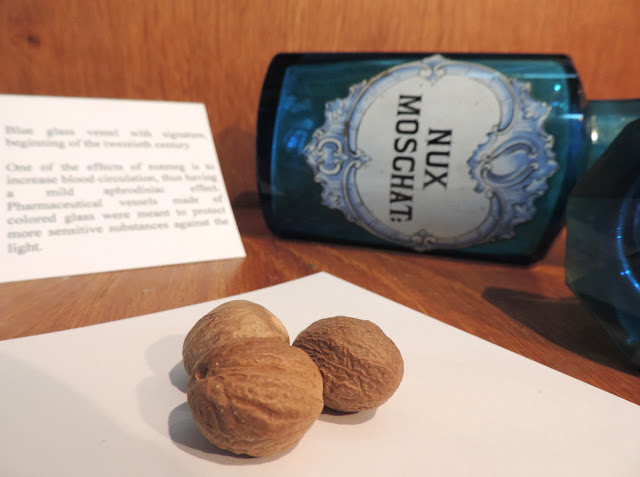As
the name indicates, nutmeg is the nut-type fruit of the tress from the Myristica
fragrans species, native of the Molucca Islands
in Indonesia, also knows as
the Spice Islands. Nutmeg was used in India
traditionally as a cooking spice, but also as a hallucinogen and an
aphrodisiac. Arab merchants brought it to Europe
in the sixth century, where it was well-known by the twelfth century. It
increases blood circulation, fights sleepiness, and is also recommended for
cardiac afflictions. The medicinal properties of nutmeg are based on the
essential oil they contain and that has the following effects: stimulant, carminative
(calms abdominal pain and favor the evacuation of intestinal gas) and in larger
dosage narcotic. The oil is also often employed in hiding the unpleasant taste
of other medicine.
 |
| Detail of nutmeg and blues apothecary glass for such nuts, from the temporary exhibition "The History of aphrodisiacs" |
The History of Pharmacy Collection in Cluj-Napoca includes five jars for this products, apparently often for entire nuts (Nuces Moschatae) or their oil (Oleum Nucis Moschatae). The majority of the jars were once used in the old St. George’s pharmacy (two glass jars with painted Baroque signatures from the eighteenth century and one blue glass bottle with faceted glass stopper, from the beginning of the twentieth century). Another jar, made of porcelain, has a bilingual inscription – Latin and Hungarian – and was also used in Cluj, in the Mathias Corvinus apothecary shop. The wooden jar was used during the nineteenth century in a pharmacy from Baia Mare.
 |
| Eighteenth-century nutmeg oil glass jar. Signature in Baroque cartouche with vegetal volutes and crown. |
 | |||
| Nineteenth-century porcelain jar with bilingual signature. |
The collection also preserves the stained glass shop sign of the Mathias Corvinus pharmacy in Cluj-Napoca. The work is signed and dated 1919 and it depicts the kneeling knight - king of Hungary born in Cluj. The cult of king Mathias was blooming in the city during the nineteenth and the beginning of the twentieth century, so it was only natural that a pharmacy located in the center would would depict him and bare his name.
 |
| Detail of Mathias Corvinus depicted on the pharmacy shop sign |



1 comment:
Thank you for this interesting article and the nice photos.
Post a Comment